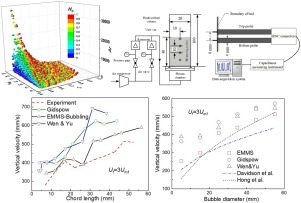Particuology ( IF 4.1 ) Pub Date : 2019-02-22 , DOI: 10.1016/j.partic.2018.08.008 Hao Wang , Youjun Lu

|
Bubbles formed during chemical processes in fluidized beds govern the bed hydrodynamics and operational efficiency, thereby having a significant impact on their design and scale-up. In this study, a two-fluid model was used to simulate the bubble behavior in a quasi-two-dimensional fluidized bed within the bubble-based energy minimization multiscale (EMMS) approach. We performed experiments to verify the model and proposed a correlation of the heterogeneous index for various parameters to calculate the coefficient of drag for the bubble-based EMMS model. Moreover, the simulation results obtained from the homogeneous drag models and EMMS bubbling model were compared with experimental data and empirical correlations. The simulation results of the EMMS approach showed good agreement with the experimental data in the distribution of the vertical bubble velocity with chord length. Compared with the results from the homogeneous models, the distributions of vertical velocity and diameter of the bubbles predicted by the EMMS-bubbling model were in better agreement with empirical correlations. Moreover, the frequency distributions of bubble properties including bubble diameter, aspect ratio, and shape factor for different gas-inlet velocities were obtained.
中文翻译:

基于气泡的EMMS模型对准二维流化床中气泡行为的数值模拟
在化学过程中在流化床中形成的气泡控制着床的流体力学和运行效率,从而对其设计和放大具有重大影响。在这项研究中,在基于气泡的能量最小化多尺度(EMMS)方法中,使用两流体模型来模拟准二维流化床中的气泡行为。我们进行了实验以验证模型,并针对各种参数提出了异质指标的相关性,以计算基于气泡的EMMS模型的阻力系数。此外,将从均质阻力模型和EMMS起泡模型获得的仿真结果与实验数据和经验相关性进行了比较。EMMS方法的仿真结果表明,垂直气泡速度随弦长的分布与实验数据吻合良好。与均质模型的结果相比,EMMS冒泡模型预测的垂直速度和气泡直径分布与经验相关性更好。此外,获得了气泡性质的频率分布,包括气泡直径,长宽比和形状因数,用于不同的进气速度。











































 京公网安备 11010802027423号
京公网安备 11010802027423号